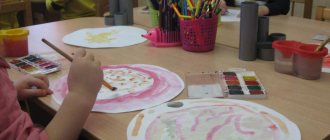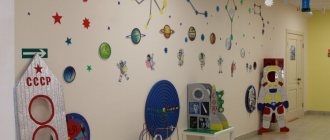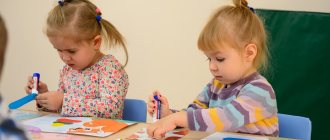Senior preschool age is children aged 5-6 years. At this age, the child begins to prepare for school activities. Therefore, the attention of parents and teachers of the senior group is focused not only on the development of personal qualities, but also on honing the skills necessary for entering the first grade.
Preschool educators and teachers working in secondary groups will be able to find in this section a lot of useful lesson notes, leisure and entertainment scenarios for children 4-5 years old.
Activities, games and holidays with children 5-6 years old.
Showing publications 1-10 of 150167. All sections | Senior group
New
Photo
The best
Direct educational activity on ecology “Visiting Lesovichka” for children 4–5 years old Municipal preschool educational institution kindergarten “Teremok”
Nikolaevsk, Volgograd region Summary of direct educational activities on ecology on the topic:
“Visiting Lesovich”
for children 4-5 years old. Compiled by: Sivko Natalya Nikolaevna Goal: Enrich...
Summary of educational activities with children of senior preschool age “Adventures of Geologists” Olga Yuryevna Mukhamedzhanova, music director, municipal budgetary preschool educational institution “Child Development Center - Kindergarten No. 140”
urban district of Samara Goal: expanding the horizons of preschoolers through various types of activities and getting to know…
Harm from “coaching” a preschooler according to the school curriculum
Yes, at first it will be very easy for the child to learn, because he already knows what his peers are going through. Therefore, he will gradually lose interest in classes. And after the stock of knowledge acquired in preschool age is exhausted, he will simply lag behind his classmates.
This opposite effect is explained by the fact that in elementary school what is needed is not previously acquired knowledge, but developed skills for educational activities. The question immediately arises about whether only the last year of preschool childhood is enough to prepare for school.
In order to simply “train” a child, this time may be enough, but in order to properly prepare for education, it is necessary to start classes in kindergarten in the senior group. Moreover, children’s education should take place in the form of a game, and not parody school lessons.
Organization of work of preschool children in cognitive cycle classes
The work begins with a repetition of what was covered in the middle group, the level of mathematical concepts is revealed. For this purpose, approximately 5 lessons are allocated, in which everything that children have learned before is consolidated - ideas about shape, quantity and magnitude, counting within 10.
The duration of classes in the senior group remains virtually unchanged, but the amount of knowledge transferred and the pace of work increase. But the activity of children is facilitated by the fact that it is carried out in the form of a game, which is very attractive for the child.
The preschool education program provides that the senior group of preschool educational institutions always begins classes with repetition, which makes it possible to introduce new knowledge into the system of previously acquired knowledge. It is carried out in the form of playful exercises, which stimulates the child’s interest. Reinforcing classes also begin with them.
Instructions for the teacher for conducting classes
In order for classes in a group of older preschoolers to be effective and interesting for children, the teacher should follow some rules.
- Classes in kindergarten in the senior group involve the presentation of new, rather complex material in the form of a game. This develops visual memory and imaginative thinking well. In addition, the competitive element present in them spurs children to better assimilate knowledge.
- It is worth devoting sufficient time to repetition. But it is not necessary to do this during the lesson; you can do several repetition sessions at the beginning of the month.
- In order not to lose children's attention, you need to monitor the change in their activities. Various types of exercises, games, songs, riddles and dances should be interspersed.
And remember that adults should communicate with children only in a friendly manner. Under no circumstances should you use a commanding tone in class, much less scold a child.
What are the features and structure of classes in the senior group?
Activities in kindergarten are given the main place. Education for older preschoolers is carried out mostly in the form of work in subgroups. This includes classes from the cognitive cycle: preparation for mastering literacy, mathematics, familiarization with the outside world, development of musical and rhythmic abilities and artistic and productive activities.
Their peculiarities are both the conduct of the entire lesson in the form of a game, and the inclusion of various game elements in its structure. This makes it easier not only for the child to acquire the necessary knowledge, but also to consolidate it. Through play it is easier to learn how to apply them in practice, since such activities are the main ones for children of this age.
The structure of a lesson in kindergarten in the senior group is determined by its program content. It usually consists of several parts (from one to five). The amount depends on the age of the children and the nature of the tasks assigned to them.
Each part of the lesson is its structural unit and includes various methods and techniques, as well as didactic tools that are aimed at achieving a specific task.
What knowledge do preschoolers acquire in math classes?
Mathematics classes in the senior group of kindergarten teach children to correctly distinguish between geometric shapes that are similar in shape, for example, a square and a rectangle, as well as analyze objects and describe their shape, evaluate sizes using three indicators: length, width and height.
In older preschoolers, the ability to determine in words how objects are located relative to each other (right, left, in front), to freely navigate in space (standing near a locker, in front of a table, behind a chair), to change the direction of one’s movement (to the right, to the left) and remember the names of the days of the week, as well as their sequence.
What mathematical knowledge do older preschoolers need?
The program for the senior group of kindergarten provides for a significant expansion and generalization of the most basic mathematical concepts, as well as counting. Children of this age must learn to count to 10 and perceive various objects, not only visually, but also by touch or by sounds.
At the age of 5 years, you can begin to form the concept that any object is divided into several parts of the same or different sizes, and you can compare them. In addition, children are convinced that sets that contain the same number of elements included in it correspond to one natural number (a star has 5 ends, 5 apples, 5 bunnies, etc.).
Lesson summary for children of senior preschool age
An educational lesson for older preschoolers aged 5-7 years with elements of practical activity. Topic: “The History of New Year’s Toys”
Description of material:
I bring to your attention a lesson summary with elements of practical activity for children of senior preschool age.
The material is intended for additional education teachers working in Early Development Centers, educators and for parents interested in the comprehensive development of preschoolers. Goal:
introduction to the culture of the New Year holiday, its traditions;
expanding and enriching children's knowledge about the history of New Year's toys. Objectives: Educational:
• introduce children to the history of the New Year holiday;
• the history of the appearance of Christmas tree decorations, Educational:
• to cultivate interest in the traditions of celebrating the New Year.
Developmental:
• to develop in children creative independence, aesthetic taste, creative abilities, imagination.
Equipment:
TV, laptop, beads and wire for making toys, bag for Christmas toys, Christmas tree.
Progress of the lesson
1. Organizational moment
We are in a great mood, and smiling is a common thing!
Let's wish each other well, It's time for us to start getting busy! 2. Setting the topic and goals of the lesson Teacher:
Girls and boys, you told me about how you are preparing to celebrate the New Year, what beautiful and elegant Christmas trees you have at home.
Teacher:
Look, someone’s bag is on the table?
(children’s answers - D. Moroz.) Teacher:
I wonder what’s in the bag?
Here are snowflakes with riddles. Maybe we can guess the riddles? Listen carefully. Suddenly the blizzards came with a terrible howl. Autumn ran away in fear, and she became the mistress. (Winter)
At least there are not cones, not needles, but hanging on the branches of a Christmas tree?
(Christmas decorations)
Teacher:
There's something else here.
Let's see what's there (takes out Christmas tree decorations.) Teacher:
What different and interesting toys
(examining toys)
A cap of snow on the mountain, All the trees are in silver, Ice sparkles on the pond, It's coming...
(New Year) Teacher:
You all love the holiday New Year?
(answers) Teacher:
It’s hard to find a person who doesn’t love the New Year.
The beautiful custom of decorating the Christmas tree arose many years ago. There was a belief that spirits live in trees, on which the future harvest and the fate of each person depend, so spirits must be respected with a variety of gifts. For a long time, Christmas trees were decorated with food - raisins, candies, nuts, cookies, pretzels, fruits, apples. Later they began to make more ornate jewelry. There were paper flowers and skillful crafts made from cotton wool and silver foil. And many, many years ago, by decree of Tsar Peter 1, it was ordered that January 1 be considered the beginning of the New Year, as in other countries. Everyone had to congratulate their relatives and friends on the holiday and decorate the Christmas tree. New Year's festivities were necessarily accompanied by games, songs, and dances. Teacher:
Get your hands ready.
Finger game
We had fun at the Christmas tree,
(Rhythmic clapping of hands)
And danced and frolicked
(Rhythmic fist bumps)
Afterwards, kind Santa Claus presented us with gifts.
(“Walk” with your middle and index fingers on the table)
.
He gave me huge bags, with delicious items in them: (rhythmic clapping of hands)
.
Candies in blue pieces of paper, (Fold the fingers on one or both hands, starting with the thumb)
.
Nuts next to them, a pear, an apple, one Golden tangerine. Teacher:
And at 12 o’clock at night, Peter I went out onto the square with a torch in his hands and launched the first rocket into the sky.
Thus began the fireworks in honor of the New Year holiday. Therefore, at exactly 12 o’clock at night, we say goodbye to the old year and welcome the New Year. Teacher:
How do they decorate the Christmas tree now?
(children's answers) Teacher:
So what kind of toys used to decorate the Christmas tree?
Let's look at the illustration: Glass, cardboard, cotton wool, porcelain. During the war years, captured Germans taught our craftsmen how to blow balls and beads. When it was wartime, Christmas tree decorations were made like this - soldiers, airplanes, various military vehicles. Military battles were even painted on balloons. When peacetime came, the toys immediately turned into fairy-tale characters, houses and Christmas trees, animals, vegetables and fruits and, of course, many colorful balls. But look - the Christmas tree of your fathers and mothers, grandfathers and grandmothers. Now the Christmas tree is most often decorated with multi-colored balls and various toys, glass and plastic, they are very easy to use and do not break. And there are unusual Christmas trees: made of balls, made of donuts, made of tinsel, and many other different ones, as much as your imagination can handle. Every year, different cities in our country put up Christmas trees on the main square of their city. They are large, all in lights and shimmer in different colors. And it's just fabulous! And of course, all the children dress up their green beauties at home. Christmas tree decoration made of beads Practical work
You will need: green, red and white beads, tinsel
(rain)
on a thin wire. Prepare 4 pieces of wire of the same size. 1. Twist 2 pieces together in the center to make 4 rays.
2. Add 2 pieces of wire to make 8 rays. String the beads onto the rays, alternating colors, leaving the ends of the wire pieces free. 3. Connect the ends of the wire, then twist them. 4. Shape the blank into a ball and decorate the Christmas tree.
5. Summary of the lesson
Guys, who remembers what toys they used to decorate the Christmas tree in the old days? And what do they decorate with now? What materials are modern Christmas tree decorations made from? Is it possible to make toys yourself? What a great fellow you are!
6. Reflection
"Snowflakes"
Attach a white snowflake to the board if the lesson went well, everything was clear and you are happy with your application
Attach a blue snowflake to the board if the lesson was difficult for you, uninteresting, or nothing was clear.
What is the purpose of classes with preschoolers?
Since the kindergarten has taken over the issue of high-quality preparation of preschoolers for study in the 1st grade, the senior group now takes the same classes as the preparatory group, so that the children have time to develop the necessary skills, perseverance, and the ability to think logically.
The task of the teacher in this case becomes to transfer to children not only the necessary knowledge, but also skills and abilities. This makes it possible to develop curiosity in the child, the ability to work together, independence, and also enriches spiritual and physical culture.
All teachers of preschool institutions must prepare notes for classes in kindergarten. A preschool educational institution that begins to work according to the FOGS system sets the main requirement for training as the presence of various game elements in any of them. Through this form, children acquire the necessary knowledge and skills much better.
The benefits of rhythmic exercises for children
In addition to classes to prepare for literacy, reading and basic mathematical concepts, the preschool program provides for the development of musical and rhythmic abilities in children. For this purpose, many preschool educational institutions have included rhythm classes.
Experience shows that such activities in kindergarten and in the senior group not only bring joy to the child and amuse him, but also have many other positive factors. Among them are the following:
- They instill a love of dancing and music and develop musical taste.
- Thanks to them, shy children can relax, and active ones get good physical relaxation.
- All children begin to share concepts such as the style of music, its rhythm and tempo.
- Both the child’s physical fitness and coordination of movements improve significantly.
- Children have the opportunity to learn how to react adequately to any situation, control their state of mind and correctly express emotions.
All this led to the fact that great attention began to be paid to rhythm classes in the preschool education system.
Since mothers and fathers always want to know what their child is doing in kindergarten and what he is learning there, especially if the institution’s program includes classes that are not included in the compulsory preschool program, the kindergarten most often strives to conduct an open lesson on rhythm in the senior group simultaneously with parent meeting.
This is done so that it is possible to demonstrate to parents the skills and abilities acquired by their children, as well as the style of conducting lessons.



